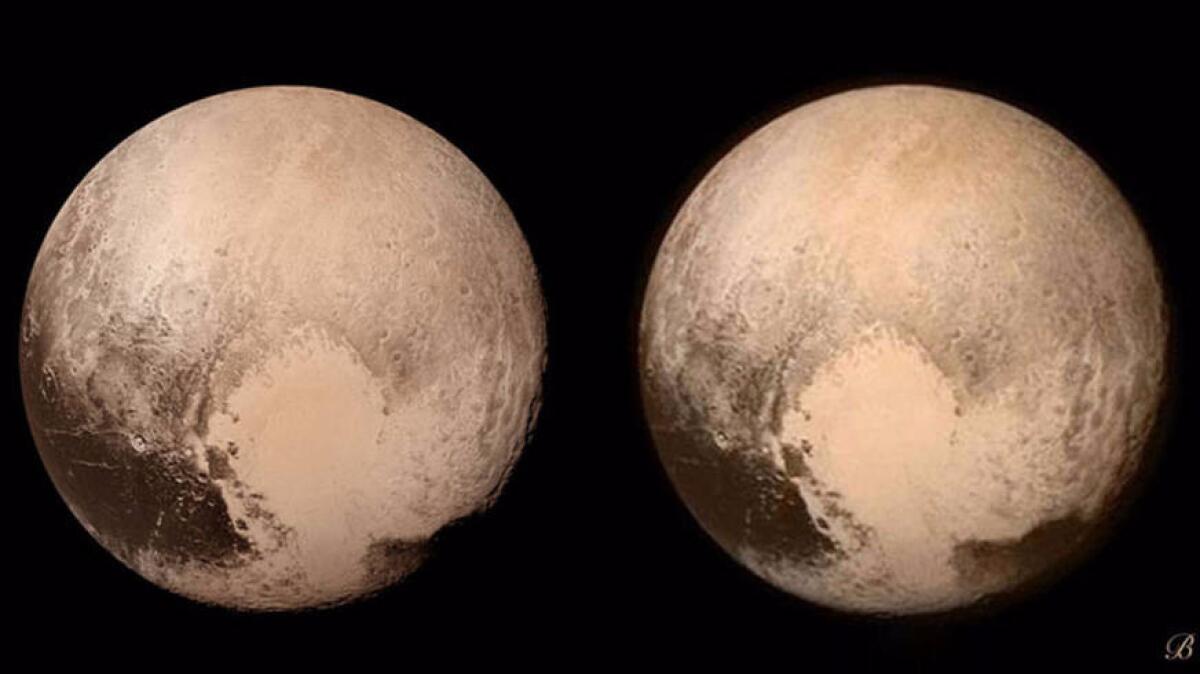Does Pluto have a hidden ocean? Its ‘heart’ holds a clue

- Share via
Pluto’s “heart” is spilling its secrets. Scientists using data from NASA’s New Horizons mission have found more evidence that there may be an ocean beneath the dwarf planet’s surface.
The findings, published by Geophysical Research Letters, could shed light on the internal mysteries of this frigid, distant little world.
“Before New Horizons, I would have bet that it was completely frozen,” lead author Brandon Johnson, a planetary scientist at Brown University, said of the dwarf planet.
Johnson focused on Sputnik Planum, a feature on Pluto’s surface whose origins were discussed during last year’s American Geophysical Union meeting in San Francisco. The roughly 560-mile-wide basin sitting in the western lobe of the little world’s giant “heart” feature seems to have been dug out by a space missile that was at least 125 or so miles across.
If the feature was really a giant crater at some point, then it should have less mass than other parts of the surface, given that bits of it would have blasted away by the impact. But the gravitational bond between Pluto and Charon, its largest moon, seemed to treat Sputnik Planum as if it had extra mass.
Pluto and Charon are tidally locked — that is, they always show the same face toward each other. And Sputnik Planum lies right on the tidal axis between them. Since Charon’s gravitational pull should have slowly tugged the most massive bit of Pluto into line, this probably means that there must be some extra mass inside of Sputnik Planum.
If that’s the case, then the chemical contents of Sputnik must be heavier than the original surface would be. Part of that extra mass could come from the layer of nitrogen ice partly filling the basin, but that still isn’t enough to explain the anomaly, Johnson said.
So the scientists ran simulations of the kind of impact that would have carved out this giant crater. The impact would have caused the material in the area to rebound upward — and that would pull up more stuff, including water, from deep within the planet. Liquid water is already denser than ice, and salty water is even more so. This, together with the extra nitrogen ice, could account for that extra mass in Sputnik Planum.
The scientists calculated that the dwarf planet probably hosts an ocean that is more than 62 miles deep, and with enough salt to make it about as dense as the Dead Sea. This ocean would need a healthy dose of ammonia (along with the extra salt) to help keep it liquid at a frigid minus 27 degrees Fahrenheit.
The scientists’ findings could shed light on the internal dynamics of the dwarf planet. The salt content, for example, might hint at how much the water had interacted with Pluto’s rocky core.
Johnson said this underground ocean probably isn’t life-friendly. At least Saturn’s moon Enceladus and Jupiter’s moon Europa, while both crusted in ice, are warmed by tidal heating — which means that their subsurface oceans don’t need as much salt to stay liquid.
“Compared to Enceladus or Europa, this is probably not a very good place for life to be,” he said of Pluto. “Because it’s extremely cold, and potentially extremely salty.”
But, he added, it does give hope that as scientists look for habitable worlds around distant stars, they might not have to limit themselves just to the habitable zone — the distance from a star where liquid water could potentially remain stable on a planet’s surface.
“You could have a planet that could have a habitable ocean that isn’t even in the habitable zone and it isn’t getting any tidal heating from anywhere,” he said. “But it’s got an ocean that’s under some ice and it’s got a temperature that’s conducive to life. So that’s something that I hadn’t considered, really, before being convinced that Pluto has this ocean.”
Follow @aminawrite on Twitter for more science news and “like” Los Angeles Times Science & Health on Facebook.
ALSO
The Chinese space lab is about to crash and burn — and that’s OK with China
How scientists virtually unwrapped an ancient, burned scroll and read the words inside
Studies on the perils of polyester underwear and the personality of rocks win Ig Nobel Prizes






